
Luscombe is an historic estate situated in the parish of Rattery in Devon.

Luscombe is an historic estate situated in the parish of Rattery in Devon.

Loscume is an estate mentioned in the Domesday Book of 1086, not as a separate entry, but as an estate mentioned within the entry for the manor of Dartington. [2] Dartington is listed in the Domesday Book as Dertrintone, the 15th of the 17 Devonshire holdings of William de Falaise, feudal baron of Stogursey, [3] Somerset, one of the Devon Domesday Book tenants-in-chief of King William the Conqueror. [4] Luscombe comprised one furlong of land within the manor of Dartington and was held from William of Falaise by his tenant Ansketel. Luscombe was later the seat of the Luscombe (originally de Luscombe) family from before the 16th century [5] to shortly before 1810. [6] As was usual,[ citation needed ] the family had taken their surname from their seat. Shortly before 1810 it was sold by the Luscombe family to Walter Palk (1742-1819), MP for Ashburton (1796-1811), [7] who had purchased the manor of Rattery together with several local estates, and built Marley House, a large Georgian country house, as his new seat within the parish of Rattery.
It should not be confused with Luscombe Castle, a 19th-century country house near Dawlish, about 16 miles (26 km) to the north-east.
The artist Yasmin David lived at Luscombe for most of her life, from 1923 to her death in 2009. [8]

Rattery is a village and civil parish in Devon, England, a few miles from Buckfastleigh, Ashburton, and Dartington. The name is often interpreted as a variant of "Red Tree" and is listed in the Domesday Book as Ratreu.
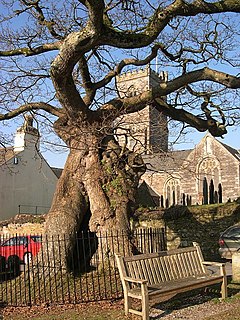
Meavy is a small village, civil parish and former manor in the English county of Devon. Meavy forms part of the district of West Devon. It lies a mile or so east of Yelverton. The River Meavy runs near the village. For administrative purposes the parish is grouped with the parishes of Sheepstor and Walkhampton to form Burrator Parish Council, and for electoral purposes it is grouped with the same two parishes to form Burrator Ward.

Bratton Clovelly is a village, parish and former manor in the west part of Devon, England. It is situated about 8 miles (13 km) south-west of Okehampton immediately north of the A30 road. The manor of Bratton Clovelly was listed in the Domesday Book of 1086. The parish church dedicated to St Mary is 15th-century, with many Norman features. The former village stocks are kept in the belfry. The parish is thought to have been the birthplace of influential 13th-century jurist Henry de Bracton; however, this claim is also made for at least two other places.

Sir John Fowell, 3rd Baronet of Fowelscombe in the parish of Ugborough in Devon, was an English politician who sat in the House of Commons from 1689 to 1692.

Roborough is a village and civil parish 5.5 mi (8.9 km) from Great Torrington. Situated topographically on the plateau between the Torridge and Taw Rivers, the parish covers 1,258 ha and contains a population of some 258 parishioners. It is surrounded by a pastoral landscape of rectangular fields, high hedges and scattered farmsteads.

Woodleigh is a village, parish and former manor located in the South Hams region of the county of Devon, England.
East Hagginton was a historic estate within the manor and parish of Berrynarbor near to the coast of North Devon. It is near to, if not actually encompassing, the site of Watermouth Castle.
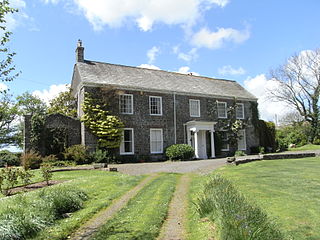
Thuborough in the parish of Sutcombe, Devon, England, is an historic estate, formerly a seat of a branch of the Prideaux family, also seated at Orcharton, Modbury; Adeston, Holbeton; Soldon, Holsworthy; Netherton, Farway; Ashburton; Nutwell, Woodbury; Ford Abbey, Thorncombe, all in Devon and at Prideaux Place, Padstow and Prideaux Castle, Luxulyan, in Cornwall. The present mansion house, comprising "Thuborough House" and "Thuborough Barton", the north-east block, is a grade II listed building.
Ralph de Pomeroy was one of the 52 Devon Domesday Book tenants-in-chief of King William the Conqueror and was the first feudal baron of Berry Pomeroy in Devon. He held 58 landholdings in Devon.

Washfield is a village, parish and former manor in Devon, England, situated about 2 miles north-west of Tiverton. The parish church is dedicated to St Mary the Virgin. It was within the jurisdiction of the historic West Budleigh Hundred.

Widworthy is a village, parish and former manor in Devon, England. The village is 3 1/2 miles east of Honiton and the parish is surrounded clockwise from the north by the parishes of Stockland, Dalwood, Shute, Colyton, Northleigh, and Offwell. The parish church is dedicated to St Cuthbert. Near the church is Widworthy Barton, the former manor house, which is largely unaltered from its early 17th century form. Widworthy Court is a mansion within the parish built in 1830 by Sir Edward Marwood Elton to the design of G.S. Repton.

Milton Abbot is a village, parish, and former manor in Devon, 6 miles (9.7 km) north-west of Tavistock, Devon, and 6 miles (9.7 km) south-east of Launceston, Cornwall.
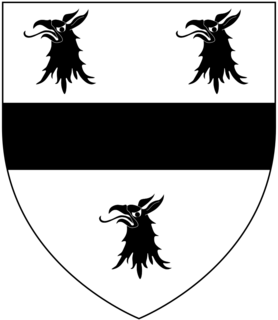
Kenedon is an historic manor situated in the parish of Sherford in Devon.

South Milton is a village and civil parish in Devon, England, situated on the south coast about 2 miles south-west of Kingsbridge. The civil parish includes the hamlets of Sutton, south of the village, and Upton, north of the village.
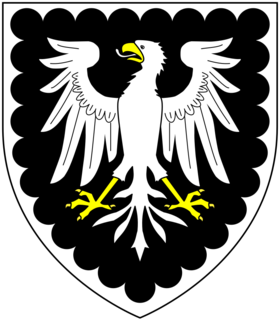
Walter Palk (1742-1819), of Marley House in the parish of Rattery, Devon, England, was a Member of Parliament for his family's Pocket Borough of Ashburton in Devon from 1796 to 1811. He served as Sheriff of Devon (1791-2) and in 1798 was a Captain in the Ashburton Volunteer Militia, one of many such units formed across Devon to counter a possible invasion by Napoleon.
The manor of Broad Hempston was an historic manor situated in Devon, England, about 4 miles north of Totnes. The present village known as Broadhempston was the chief settlement within the manor and remains the location of the ancient parish church of St Peter and St Paul.

Spurway is a historic manor in the parish of Oakford in Devon. It was the seat of the de Spurway family from before 1244 until the mid-20th century. The derelict buildings of Spurway Barton are in a remote location above a wooded combe.

Hareston is an historic estate in the parish of Brixton, about three miles from Plymouth in Devon. The mansion house built during the reign of King Henry VII (1485-1509) burned down partially in an accidental fire at the beginning of the 18th century, and in 1822 the surviving part, the Hall and Chapel, was being used as a farmhouse. It was described by Candida Lycett Green in her 1991 book The Perfect English Country House as: "The most forgotten Manor House Farm In England, untouched for hundreds of years, sits safely, impossible to find, down miles of private sunken lanes which in the spring brim with Campion, Bluebells, Purple Orchids, Primroses, Violets, Speedwell and Stitchwort. Wooded hills rise behind this, the quintessence of an ancient English Manor House".
Croker's Hele is an historic estate in the parish of Meeth in Devon, England.
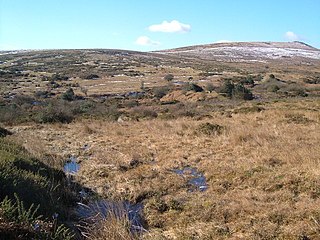
Bagtor is an historic estate in the parish of Ilsington in Devon, England. It was the birthplace of John Ford (1586-c.1639) the playwright and poet. The Elizabethan mansion of the Ford family survives today at Bagtor as the service wing of a later house appended in about 1700.